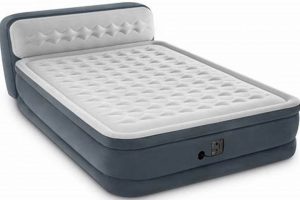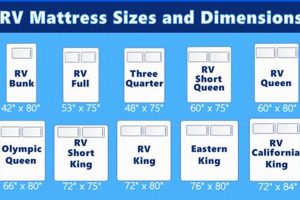Dimensions of sleeping surfaces, expressed using the metric system, provide a standardized and universally understood means of comparing and selecting bedding. This standardization allows manufacturers and consumers to communicate effectively regarding the proper fitting of sheets, bed frames, and room layouts. For example, a “single” mattress in this measurement system might typically measure 90 cm wide by 190 cm long.
Adherence to these dimensional standards facilitates international trade and consumer confidence. Accurate sizing ensures compatibility between products sourced from different regions, reducing frustration and returns. Historically, variations in manufacturing practices led to inconsistencies, which metrication helps to mitigate by providing a common reference point. This standardization promotes efficiency across the supply chain, benefiting both producers and end-users.
Therefore, understanding these standardized dimensions is crucial for making informed purchasing decisions. Subsequent sections will detail common dimensional specifications for various sleeping surface types, focusing on length and width, to assist in selecting the appropriate size for individual needs and spatial constraints. These details will cover everything from compact options to larger configurations.
Considerations for Bedding Dimensions
Selecting the correct bedding dimensions is critical for comfort and spatial optimization. This section presents crucial factors to consider during the selection process.
Tip 1: Measure Available Space: Prior to purchase, measure the intended location for the bed frame and sleeping surface. Accurate measurements prevent overcrowding and ensure adequate room for movement.
Tip 2: Factor in Occupancy: The number of occupants directly influences the required sleeping surface area. Individuals sharing a bed require a larger surface to ensure adequate personal space and minimize sleep disturbances.
Tip 3: Consider Individual Size: Taller individuals require longer bedding to prevent discomfort and ensure proper support. Standard lengths may be insufficient; therefore, consider extended-length options.
Tip 4: Evaluate Existing Bed Frames: When replacing only the sleeping surface, verify compatibility with the existing bed frame. Incompatible dimensions may render the bed frame unusable.
Tip 5: Review Product Specifications: Always consult the manufacturer’s specifications for precise dimensions. Minor variations can exist between manufacturers, potentially leading to fitment issues with bedding accessories.
Tip 6: Anticipate Future Needs: Consider future needs, such as potential changes in occupancy or the addition of sleeping partners. Selecting a larger size initially may provide greater long-term flexibility.
Prioritizing these considerations helps avoid costly errors and ensures that the chosen bedding dimensions meet individual and spatial requirements. Choosing the right dimensions optimizes comfort and promotes restful sleep.
This section has provided valuable guidance regarding bedding dimensions. The subsequent conclusion will summarize key takeaways and reinforce the importance of informed decision-making.
1. Width (cm)
The width of a sleeping surface, measured in centimeters, is a primary determinant in defining its overall dimensional classification. This dimension directly impacts the number of occupants that can comfortably utilize the surface and the spatial requirements within a bedroom. Accurate specification of this measurement is crucial for selecting bedding and frames, and for optimizing room layout.
- Individual Sleeper Space
Width dictates the available personal space for a single sleeper. A wider surface allows for greater freedom of movement during sleep, reducing the likelihood of discomfort or disturbed rest. Insufficient width can lead to constrained sleeping positions and increased restlessness.
- Multi-Occupancy Considerations
For shared sleeping surfaces, width is paramount. A wider dimension provides adequate separation, minimizing disturbances caused by movement or differences in sleep patterns. Insufficient width can result in overcrowding and compromised sleep quality for both occupants.
- Bed Frame Compatibility
Width directly influences compatibility with bed frames. Inaccurate width specifications can result in an ill-fitting sleeping surface, rendering the frame unusable or compromising support. Standardized width dimensions facilitate selection of appropriately sized frames and bedding accessories.
- Spatial Optimization
Width considerations are critical for optimizing room layout. An excessively wide sleeping surface can dominate a small space, restricting movement and creating a sense of confinement. Conversely, an undersized surface may appear disproportionate and underutilize the available space. Careful measurement and planning are essential to balance comfort and spatial efficiency.
In summary, precise determination and understanding of width, expressed in centimeters, is indispensable for ensuring both comfort and practicality in relation to sleeping surface selection. It is a foundational element for assessing occupancy, compatibility, and spatial harmony within a given environment. Neglecting this dimension can lead to dissatisfaction and functional limitations.
2. Length (cm)
The length of a sleeping surface, quantified in centimeters, represents a critical component of overall dimensional specifications. Its primary effect is to dictate suitability for individuals of varying statures. Inadequate length results in discomfort, compromised spinal alignment, and potentially, reduced sleep quality. A sleeping surface’s total dimensional characterization cannot be fully understood without a precise specification of its length. For example, a standard single sleeping surface typically measures approximately 190 cm in length, a dimension generally sufficient for individuals of average height. However, taller individuals require a length of 200 cm or more to ensure adequate support from head to toe.
Consider the practical implications of this measurement in real-world scenarios. A hospitality provider selecting sleeping surfaces for a diverse clientele must account for varying height distributions. Offering options with lengths ranging from standard sizes to extra-long versions ensures guest comfort and satisfaction. Similarly, individuals with chronic back pain often require longer surfaces to maintain proper spinal alignment throughout the night, a benefit that directly impacts their well-being. Failure to account for this dimension results in a cascade of negative consequences, ranging from customer dissatisfaction to aggravated health conditions. Accurate dimensional specifications, prominently including length in centimeters, are therefore essential for informed decision-making.
In summary, the length of a sleeping surface, expressed in centimeters, is not merely a measurement; it is a key determinant of user comfort and spinal health. Understanding its significance enables informed selection, optimizing the sleep experience and mitigating potential discomfort. Challenges arise when manufacturers do not adhere to standardized measurements, underscoring the importance of verifying dimensions prior to purchase. The proper specification of length is undeniably linked to the broader objective of promoting restful and restorative sleep.
3. Thickness (cm)
Thickness, quantified in centimeters, is a key dimensional attribute directly influencing the characteristics of sleeping surfaces. While length and width define the overall footprint, thickness governs support, comfort, and compatibility with various bed frames. Its importance extends beyond mere dimensions, impacting both the feel and functionality of the bedding. Thus, a comprehensive understanding of thickness specifications is integral to informed selection.
- Support and Firmness
Thickness directly correlates with the amount of support a sleeping surface provides. Generally, a greater thickness implies a higher density of internal materials, translating to enhanced support for the sleeper. Thicker options tend to be firmer, while thinner options are often softer. For example, a 15 cm sleeping surface may provide minimal support for heavier individuals, whereas a 30 cm surface offers substantially more. This relationship between thickness, support, and firmness is a critical factor for those with specific orthopedic needs.
- Comfort and Pressure Relief
Thickness plays a vital role in pressure distribution and overall comfort. A thicker sleeping surface can incorporate multiple layers of different materials, each contributing to pressure relief at specific points. This layering effect minimizes localized stress on joints and pressure points, leading to more restful sleep. Conversely, a thinner sleeping surface may lack sufficient cushioning, resulting in discomfort and potential pressure sores for prolonged bed rest.
- Bed Frame Compatibility and Aesthetics
The thickness of a sleeping surface affects its compatibility with bed frames and the overall aesthetic appearance of the bed. Certain bed frames, particularly platform styles, require a specific thickness range to maintain the intended appearance and functionality. A sleeping surface that is too thick can overwhelm the frame, while one that is too thin can leave unsightly gaps or compromise the intended design. Matching thickness to the bed frame is, therefore, a crucial consideration.
- Durability and Longevity
Thickness influences the durability and longevity of a sleeping surface. A thicker surface generally comprises more material, increasing its resistance to wear and tear. Thicker options often retain their shape and support characteristics for a longer duration, resisting sagging and deformation. Thinner surfaces, on the other hand, may degrade more rapidly under similar usage conditions, requiring more frequent replacement.
Therefore, thickness, measured in centimeters, is a critical attribute that interacts with width and length to define the suitability of a sleeping surface. Its influence on support, comfort, bed frame compatibility, and durability necessitates careful consideration. Selecting the appropriate thickness is crucial for optimizing sleep quality, ensuring long-term satisfaction, and maximizing the return on investment.
4. Standard naming conventions
Standard naming conventions for sleeping surfaces, such as “Single,” “Double,” “Queen,” and “King,” serve as nominal descriptors that correlate, albeit imperfectly, to specific metric dimensions. These conventions function as a shorthand for communicating approximate size, facilitating initial comparisons. However, the inherent variability within these categories necessitates a rigorous focus on exact dimensional specifications in centimeters to avoid misinterpretations and ensure compatibility with bed frames and bedding accessories.
The practical significance of understanding this connection lies in mitigating potential purchasing errors. For example, a “Queen” size sleeping surface in one region may differ by several centimeters in width or length compared to another region, despite sharing the same nominal designation. Similarly, “King” size variants, such as “Eastern King” and “California King,” possess distinct metric dimensions, requiring careful differentiation. This discrepancy underscores the importance of consulting precise centimeter measurements alongside nominal size designations.
In conclusion, while standard naming conventions offer a convenient shorthand for describing sleeping surface sizes, they are inherently imprecise. The translation of these names into specific metric dimensions varies across manufacturers and geographic regions. Therefore, relying solely on nominal size designations can lead to errors in purchasing decisions. Prioritizing the examination of precise centimeter measurements alongside standard naming conventions remains essential for ensuring accurate product selection and compatibility.
5. European vs. US standards
Dimensional standards for sleeping surfaces exhibit significant divergence between European and US systems, directly impacting the interpretation and application of metric measurements. While both systems utilize centimeters for precise specification, nominal size designations (e.g., “Twin,” “Double,” “Queen”) correlate to vastly different metric dimensions depending on the region of origin. This divergence stems from historical manufacturing practices, variations in average body sizes, and differing consumer preferences. Failure to recognize these discrepancies can lead to significant purchasing errors and incompatibility issues. A “Queen” size sleeping surface in the US, for instance, is substantially wider and longer than a similarly designated sleeping surface in most European countries. This dimensional disparity is particularly relevant in international commerce and for individuals relocating between continents.
The practical significance of understanding these regional differences extends to several key areas. Bed frame compatibility is paramount: a US-sized sleeping surface will not fit a European-sized bed frame, and vice versa. Similarly, bedding accessories, such as fitted sheets and mattress protectors, are manufactured to conform to specific regional dimensions. Attempting to use US bedding on a European sleeping surface (or the reverse) results in poor fit and reduced functionality. Furthermore, interior designers and architects must account for these dimensional variations when specifying furniture for international projects, ensuring that sleeping surfaces are appropriately sized for the available space and compatible with locally sourced frames and accessories. Misinterpreting these standards creates project delays, cost overruns, and dissatisfied clients.
In summary, the distinction between European and US dimensional standards for sleeping surfaces is not merely a technical detail but a practical consideration with far-reaching implications. While metric measurements offer a common language, the correlation between nominal size designations and actual metric dimensions varies considerably across regions. Recognizing these variations is essential for avoiding purchasing errors, ensuring bed frame and bedding compatibility, and facilitating accurate specification in international projects. Diligence in verifying precise metric dimensions, alongside nominal size designations, remains the key to navigating this complex landscape and achieving optimal results.
Frequently Asked Questions
This section addresses common queries regarding sleeping surface dimensions, focusing on precise metric measurements to ensure clarity and accuracy.
Question 1: Why is it crucial to know sleeping surface dimensions in centimeters?
Precise metric measurements facilitate accurate comparisons between different manufacturers and models. Nominal size designations (e.g., “Queen,” “King”) vary, leading to potential purchasing errors. Centimeter measurements provide a universal standard for ensuring proper fit with bed frames and bedding.
Question 2: How do European and US sleeping surface standards differ in terms of metric measurements?
While both systems utilize centimeters, nominal size designations correspond to different dimensions. A “Queen” size in the US differs significantly from a “Queen” size in Europe. Verify precise metric measurements to avoid incompatibility when purchasing internationally.
Question 3: What is the typical length, in centimeters, recommended for individuals of above-average height?
Standard lengths often prove insufficient for taller individuals. Consider a length of 200 cm or greater to ensure adequate support and comfort. Measure the individual’s height to determine the optimal length.
Question 4: How does sleeping surface thickness, measured in centimeters, affect support and comfort?
Thickness directly correlates with support and pressure relief. Thicker sleeping surfaces generally offer greater support and more effective pressure distribution. The specific thickness required depends on individual weight and preferred firmness.
Question 5: Are “Single,” “Double,” “Queen,” and “King” size designations consistent across all manufacturers?
No. These designations are nominal and approximate. Precise metric dimensions vary significantly between manufacturers. Always consult the centimeter measurements provided by the manufacturer.
Question 6: Where can accurate metric measurements for various sleeping surface sizes be found?
Consult the manufacturer’s product specifications. Reputable retailers provide detailed dimensional information in centimeters. Third-party review websites often include detailed product specifications, but always verify the information with the manufacturer.
Understanding sleeping surface dimensions in centimeters is essential for making informed purchasing decisions. Accurate measurements prevent compatibility issues and ensure optimal comfort.
The next section will provide guidance on choosing the right sleeping surface based on individual needs and preferences.
Conclusion
This exploration has underscored the critical importance of “mattress sizes in cm” when selecting bedding. Standard naming conventions, while commonly used, lack the precision necessary for informed decisions. Metric measurements provide a universally understood and verifiable standard, facilitating compatibility between sleeping surfaces, bed frames, and bedding accessories. Furthermore, the significant dimensional disparities between European and US standards necessitate a rigorous focus on centimeter specifications to avoid costly errors, especially in international contexts.
Therefore, diligent verification of metric dimensions is paramount. Consumers and industry professionals alike should prioritize precise centimeter measurements over relying solely on nominal size designations. This focus on accurate dimensional specifications will promote compatibility, enhance consumer satisfaction, and minimize the risks associated with incompatible bedding systems. The long-term benefits of prioritizing accurate “mattress sizes in cm” far outweigh the initial effort required for verification.






![Best Queen Size Mattress with Boxspring [Deals!] Organic & Natural Mattress Buyer’s Guide: Non-Toxic Sleep Solutions Best Queen Size Mattress with Boxspring [Deals!] | Organic & Natural Mattress Buyer’s Guide: Non-Toxic Sleep Solutions](https://mattressworldpa.com/wp-content/uploads/2025/07/th-2253-300x200.jpg)
![Futon vs Reg Mattress Size: Are They The Same? [Guide] Organic & Natural Mattress Buyer’s Guide: Non-Toxic Sleep Solutions Futon vs Reg Mattress Size: Are They The Same? [Guide] | Organic & Natural Mattress Buyer’s Guide: Non-Toxic Sleep Solutions](https://mattressworldpa.com/wp-content/uploads/2025/07/th-2252-300x200.jpg)